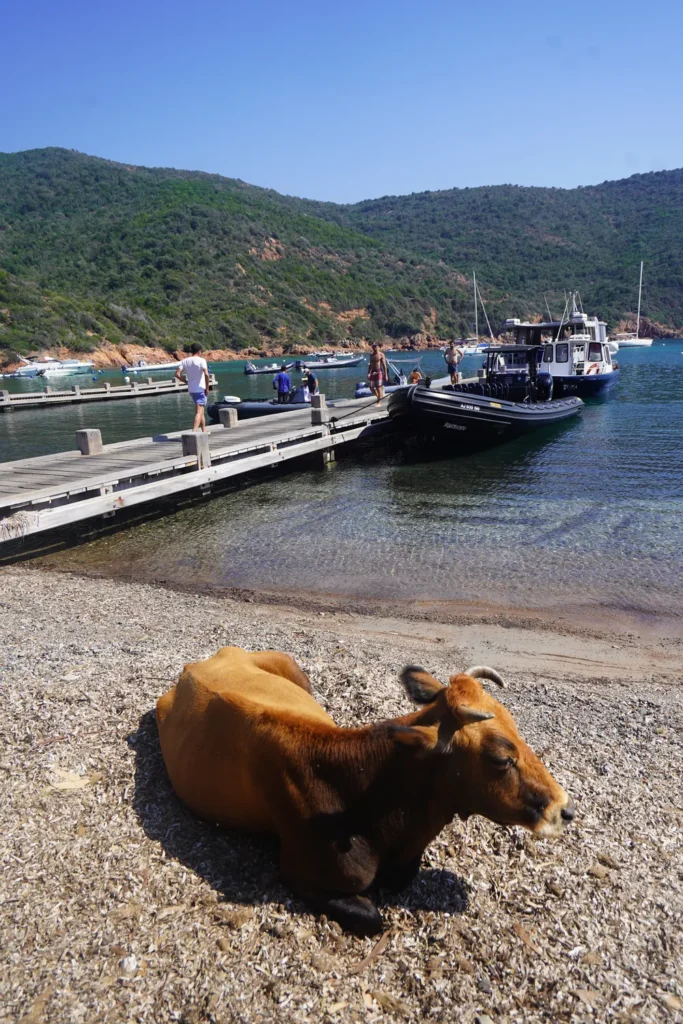On board a Windy SR44, we undertook a 200 nautical mile express trip from Sardinia to Corsica and the Côte d’Azur and still found time to anchor in the region’s most beautiful sandy and rocky bays.
Photos: Louis Jeunet
You get your first impression of the spectacular beauty of the Costa Smeralda on the drive from Olbia airport to Porto Cervo. A narrow road, shimmering in the summer heat, winds its way up a steep hill. At the top, a panorama opens up that takes your breath away. A ribbon of rock, reminiscent of the finest lace in places, stretches seemingly endlessly along the turquoise sea. Many luxury hotels and villas stand right on the water’s edge, but the Aga Khan wanted them to be so well embedded in the surroundings that they would not spoil the landscape.
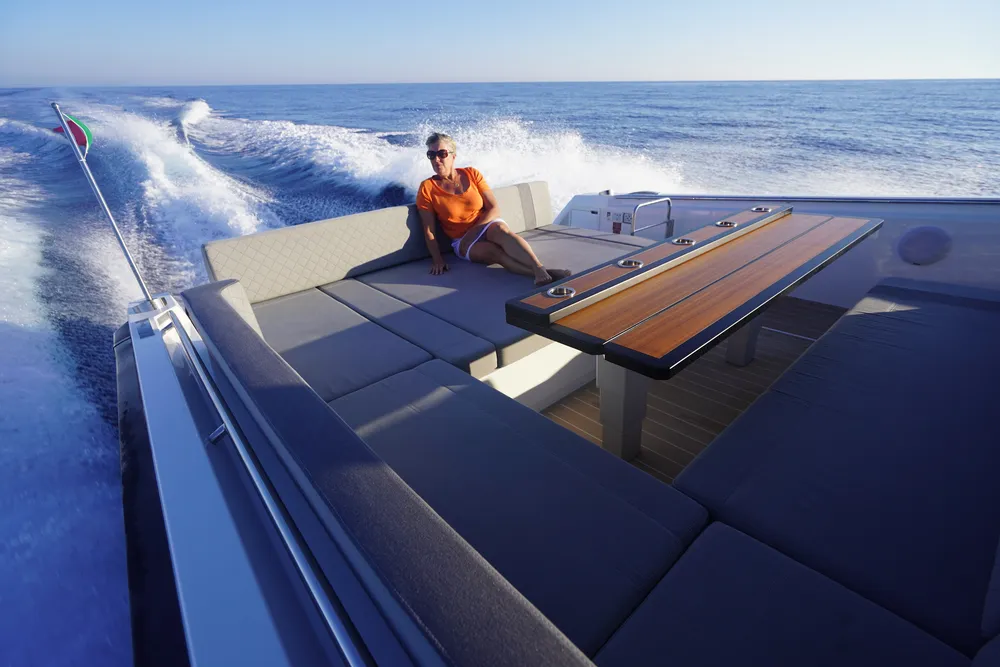
Happy Few from around the world
When Karim Aga Khan IV visited the region in 1962, he is said to have fallen head over heels in love with the Sardinian coast. The billionaire was particularly taken with what would later become the “Spiaggia del Principe” (Prince’s Beach). He bought the wasteland for a ridiculously low price, christened it the “Emerald Coast” and over the years developed an exclusive vacation resort for wealthy people there.
Today, the Costa Smeralda is no longer reserved for the rich and famous, but remains a hotspot for high society. Hardly anywhere else can you find so many mega yachts and luxury cars in such a small area. Most of them are located in Porto Cervo, a seaside resort with a marina that has risen from the ground and where the prices for an overnight stay are beyond imagination.
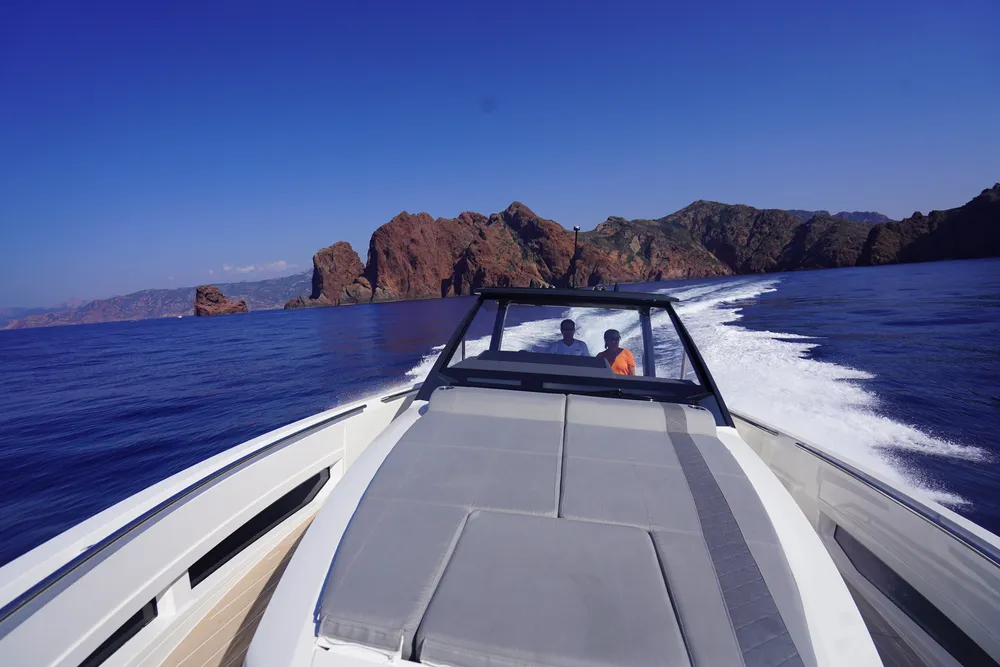
TO THE CÔTE D’AZUR ON THE FRENCH MAINLAND.
In this exclusive marina, we board a Windy SR44 in the late afternoon for an express cruise. The motor yacht has to be on the Côte d’Azur in 48 hours at the latest, otherwise we have free rein. We can plan the route and stages as we wish. The weather should not set us any limits, the forecast is for bright sunshine. We want to pack as much cruising feeling as possible into the two days and head for the best-known but also the most secret anchorages between Sardinia and Corsica.
Racers and high-tech yachts
Porto Cervo has retained much of its charm with its pretty houses built into the hillside and the unspoilt shore. The legendary yacht club, on the other hand, is housed in a large, uninviting building from the 1960s. Regatta boats are moored on the jetties alongside modern yachts from Bluegame, Ferretti and Azimut. The Italian boat owners have good taste! The owner of our Windy is a frequent boater. The two 16-inch Garmin screens on the dashboard illustrate his excursions since taking delivery of the SR44 two months ago: the lines form a firework display set off from Porto Cervo. The most popular destinations are obviously the Costa Smeralda and the La Maddalena archipelago, where the incomparably beautiful anchorages on the islands of Caprera and Spargi can be found. There are also a few stops in Budelli, one in Cavallo and two or three return trips to Bonifacio. However, he has not yet ventured to the east and west coasts of Corsica.
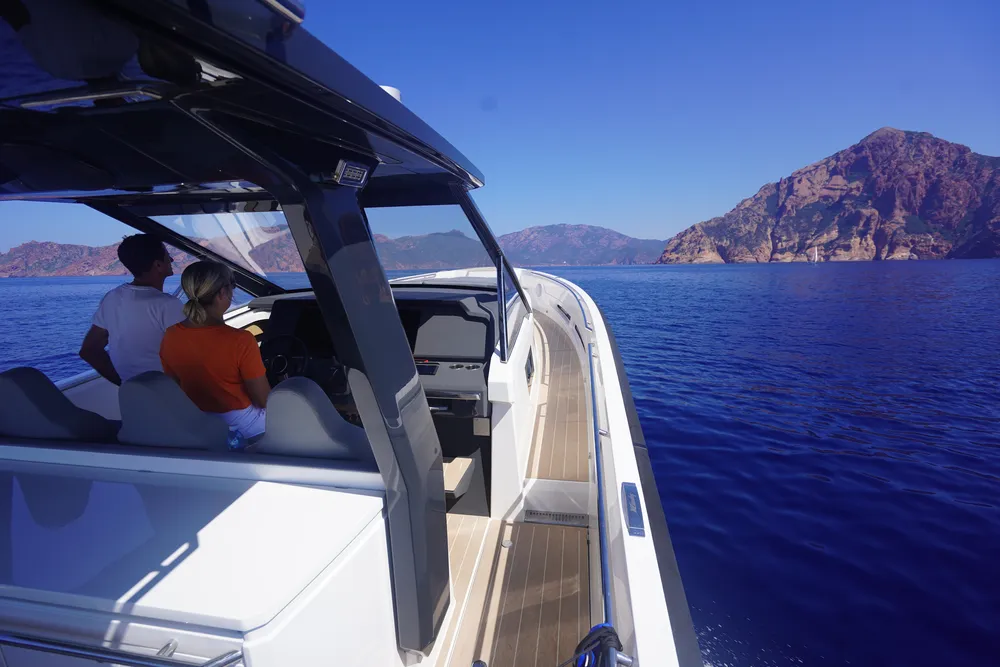
INTO THE SPECTACULAR GULF OF PORTO.
Fast, quiet boat
With its exceptionally soft hull, the Windy follows its course without forcing. It sails swiftly off the Sardinian coast across the gently shimmering sea. Its cruising speed is between 30 and 32 knots, with an average consumption of approx. 130 l/h. The model is equipped with an IPS650 drive coupled to Volvo D6 engines with 480 hp each. A powerhouse that is less sporty than the outboard version with 3 x 425 hp, which is capable of speeds of over 50 knots, but is better balanced and more economical in terms of consumption over longer distances. You don’t have to get loud to understand each other. The engine compartment is surprisingly well soundproofed, which is worth its weight in gold on long journeys. After less than half an hour, our SR44 pushes the bow under the bridge between La Maddalena and Caprera. It is closed to sailing boats and motor yachts with flybridges higher than 5 meters. For everyone else, the strait between the two islands offers some exceptional anchorages.
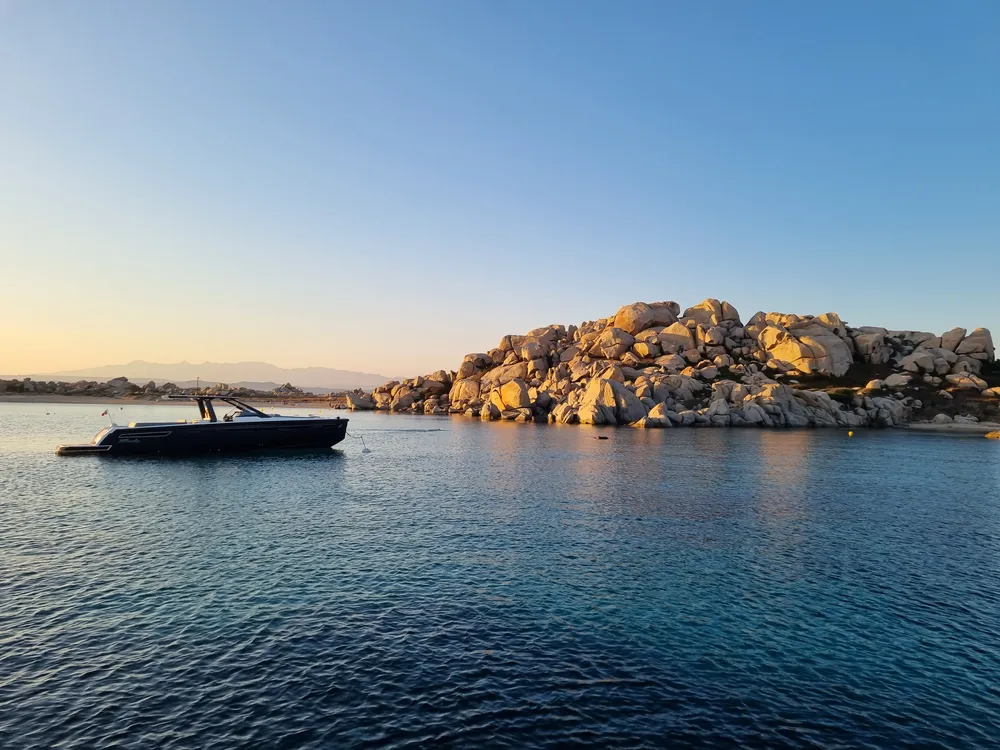
A MINEFIELD OF POLISHED GRANITE BLOCKS.
Not overcrowded even in summer
We are in a marine reserve that is only partially developed on the La Maddalena side. The north-western side of the neighboring island of Caprera even appears to be completely untouched. The Italians love these coasts. They are much more rugged than those of Corsica and offer countless wild anchoring opportunities. We first stop near Cala Faldarini, where we refresh ourselves with a dip in the cool water. We then continue at the same pace to the most popular group of islands in the Strait of Bonifacio. Budelli, azzoli and Santa Maria surround a natural emerald green pool. Most boats moor in the bays with the clearest water. In some you can see 3 to 4 meters to the sandy bottom. You have to weave your way between the rocks, always keeping an eye on the depth sounder, as the bottom rises steeply in places. There are already thirty boats when we pass through. A line of buoys between the coast and the islet of Carpa prevents us from anchoring at the most beautiful spot, the “Budelli Pool”, because this truly magical place has become a victim of its success. The marine park authorities have taken draconian measures to prevent overcrowding in the summer. Going ashore is now prohibited. The same applies to the “pink beach” at Budelli. Visitors had made a habit of taking home whole loads of the unique pink sand. Some had no scruples and even traded it. The situation became so critical that the authorities had to crack down. From Budelli, the Lavezzi archipelago is just a stone’s throw away: just under a quarter of an hour to Cala di u Lioni.
Tizzano, picturesque anchorage and good food
On site, we marvel in fascination and somewhat skeptically at the precarious balance of the wind-swept rocks. The most famous bay is Cala Lazarina. As soon as the days get a little warmer, Italian and French boaters flock to it. Here, too, drastic measures had to be taken to prevent the bay from bursting at the seams. In early summer, four anchorages were marked with yellow buoys. Since then, it has no longer been possible to anchor near the La Sémillante cemetery. The warship was wrecked on the reefs in 1853. None of the 444 sailors survived. In the early evening, the passenger ships have left and only a few boats remain at anchor. We take the opportunity for one last swim in this fairytale setting before setting course for Bonifacio. The last rays of the setting sun accompany us as far as the chalk cliffs. We decide to continue our journey to Tizzano, 18 nautical miles from Bonifacio, before darkness falls completely. On our course to the north-west, we see enough until the end. There is a small marina in the bay – a rarity on the west coast. When we moor at the first floating dock, it is pitch dark. There’s not much water under the hull, but it’s enough for the Windy, which has a draft of just 1.10 meters with the IPS. It is no coincidence that we have moored in Tizzano. This is where the most popular restaurant terrace in the region is located. “Chez Antoine” is an institution that is praised by boaters from all over the world. The menu features fresh fish and beef from the charcoal grill.
Idyll on Tivella
The small hut that serves as the harbour master’s office in Tizzano is closed. We spend the night free of charge. We set off early the next morning and anchor just a few nautical miles north of the pretty beach at Tivella. With the exception of a few hikers, it seems deserted. Tivella is a fair-weather anchorage, sheltered from the prevailing winds and less crowded than Roccapina or Conca. We find plenty of space between the few sailing boats that have spent the night here. The place is of beguiling beauty.
Next, we head for the port of Cargèse. The three deep gulfs of Valinco, Ajaccio and Sagone pass to starboard on the 38 nautical miles to get there. We pass the Sanguinaires just a few hundred meters away. From here, it’s not far to Ajaccio. A handful of boaters are fishing nearby, with the imposing island towering behind them. A wonderful sight!
Girolata and the Scandola nature reserve
Boaters off the west coast of the island are familiar with the Cargèse filling station, as you can count the number of ports between Ajaccio and Calvi on one hand. Before the long crossing to the mainland, we visit the bay of Girolata. The picturesque fishing village on the Gulf of Porto can only be reached via a steep footpath and is the highlight of any serious Corsica cruise. In summer, however, it can hardly defend itself against the influx of boats.
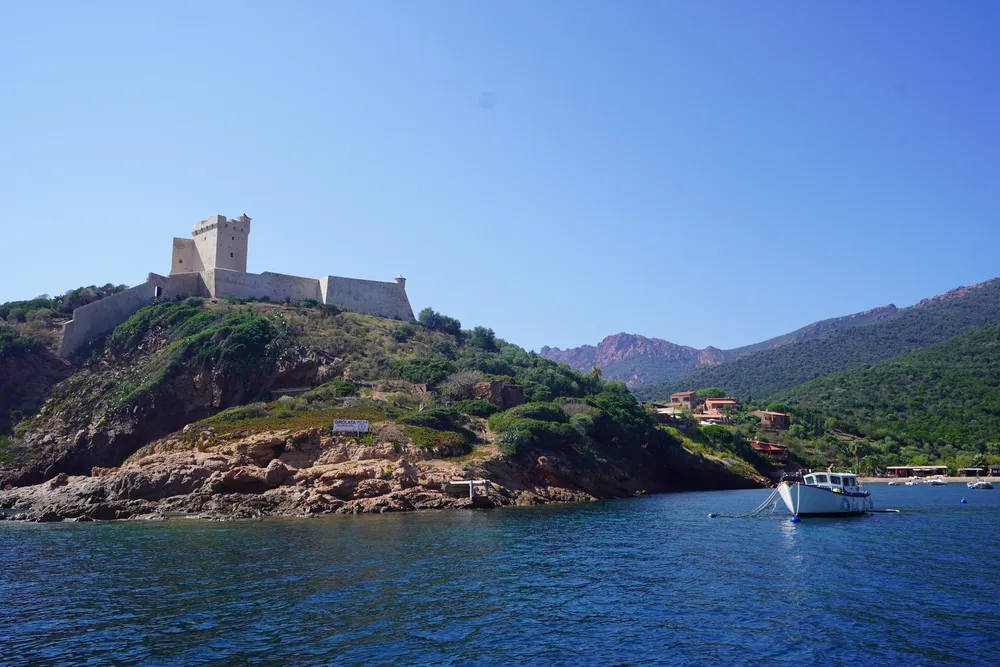
The municipality reacted and installed mooring buoys for a fee a few years ago. The measure was effective and was also a success because the anchor chains often got tangled up in each other due to the night-time currents. Since our last visit, the place has become more beautiful. The small Genoese fort above the bay was restored last year and several new restaurants have opened on the beach alongside a few junk shops. Obviously, mass tourism does not stop at Girolata. The small village seems to be right on trend, especially as you can also visit the Scandola nature reserve by sea from here. The large passenger ships have been replaced by a large number of sporty RIBs, which wash dozens of visitors ashore every day from Porto, Calvi and Ajaccio. Despite everything, Girolata remains a paradise and unique in its kind. We are also reluctant to leave the village. Our express cruise ends with a coastal trip along the red porphyry cliffs on the Scandola peninsula. At the western tip of the nature reserve lies the small island of Gargalo. This is where we stop time for our last leg of the trip. After less than 3.5 hours, we arrive in the old port of Cannes in the early evening. This includes several stops to observe schools of dolphins. We even saw a fin whale about ten meters long!
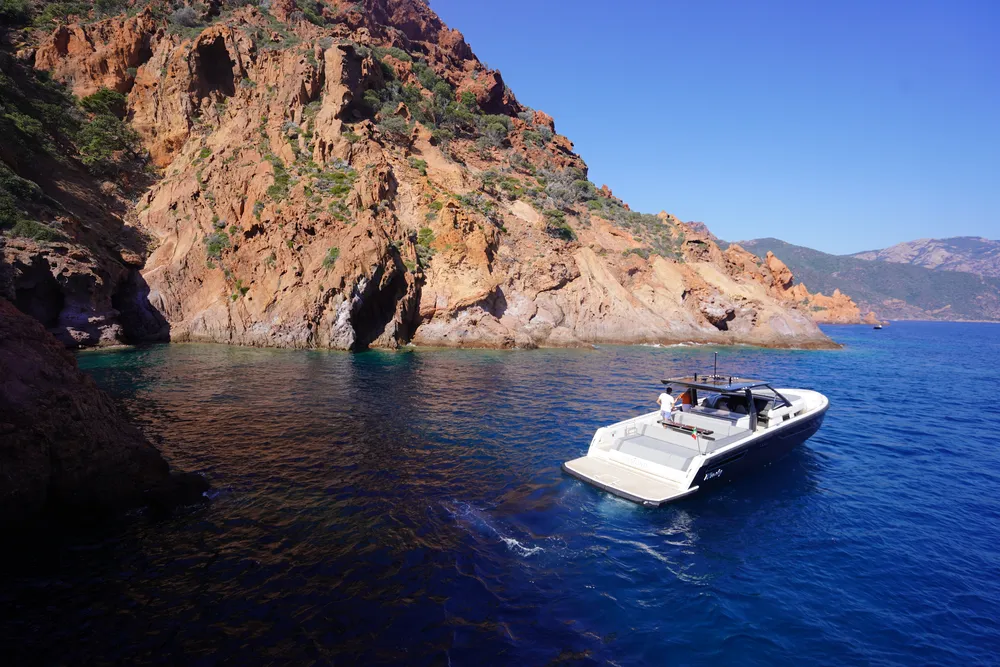
OF THE SCANOLA NATURE RESERVE, YOU CAN ANCHOR CLOSE TO THE STEEP COAST.
Travel information
Recap of the crossing (Corisca – Cannes)
95 nautical miles covered, 30-31 knots average speed, 370 liters of fuel. The crew disembarked less than 48 hours after the start in Porto Cervo, but have the exhilarating feeling of having been underway for a whole week. You lose track of time at sea!
Technical info
Windy SR 44: Length: 13.32 m
Width: 3.95 m
Draught: 1.10 m
Weight: 10 tons
Motorization: Volvo IPS600 (2 x 480 hp)
Fuel tank: 900 l
Water tank: 300 l
Cabins/berths: 2/4
Price: approx. 1,450,000 euros (fully equipped)
Manufacturer: Windy, Sweden
Best time to visit
From April to the beginning of November. The most popular travel time for cruise lovers is the summer, but the low season is not to be sneezed at either. One disadvantage can be the somewhat cooler temperatures. Warm clothing is therefore a must in your luggage. The cooler days and nights are the price you have to pay for deserted anchorages. The water temperature is above 20°C from June to November. It peaks at 25°C in August.
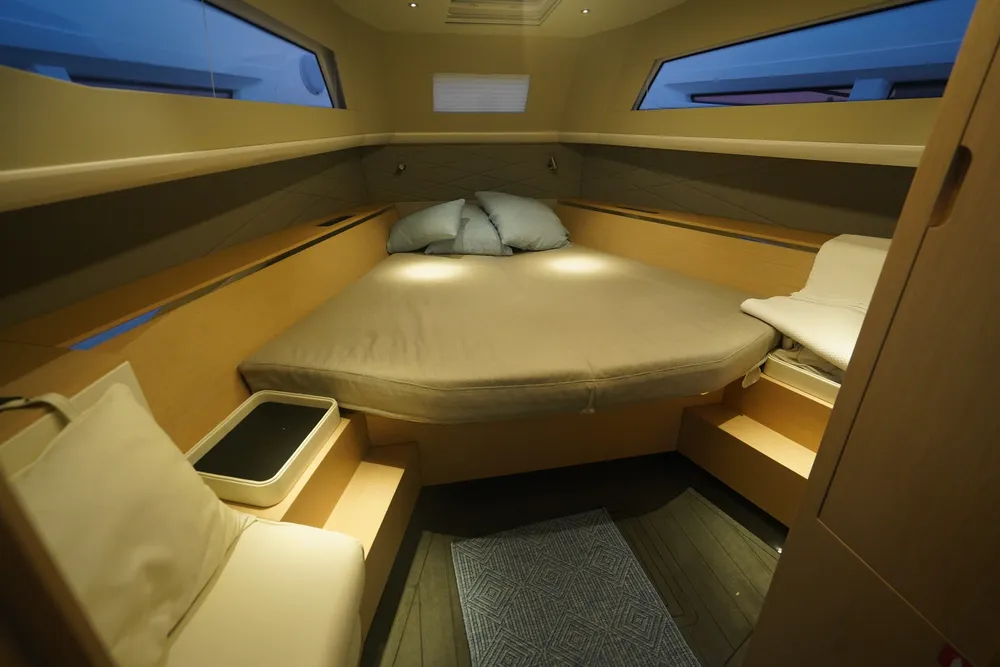

Navigation
The Strait of Bonifacio is treacherous and not without danger. Plan your route well in advance and keep an eye out for dangers and shallows, especially in bad weather. Due to the Venturi effect between Corsica and Sardinia, the wind can pick up very quickly. Do not sail against the wind in strong winds. From the beginning of May to the end of October, you must pay a fee for the La Maddalena National Park, depending on the length of your boat and the length of your stay. Information and regulations: lamaddalenapark.it
For customized trips and/or cruises
Contact Fabienne from The Yacht Experience:
fabienne@the-yacht-experience.ch or +41 76 378 56 04.
